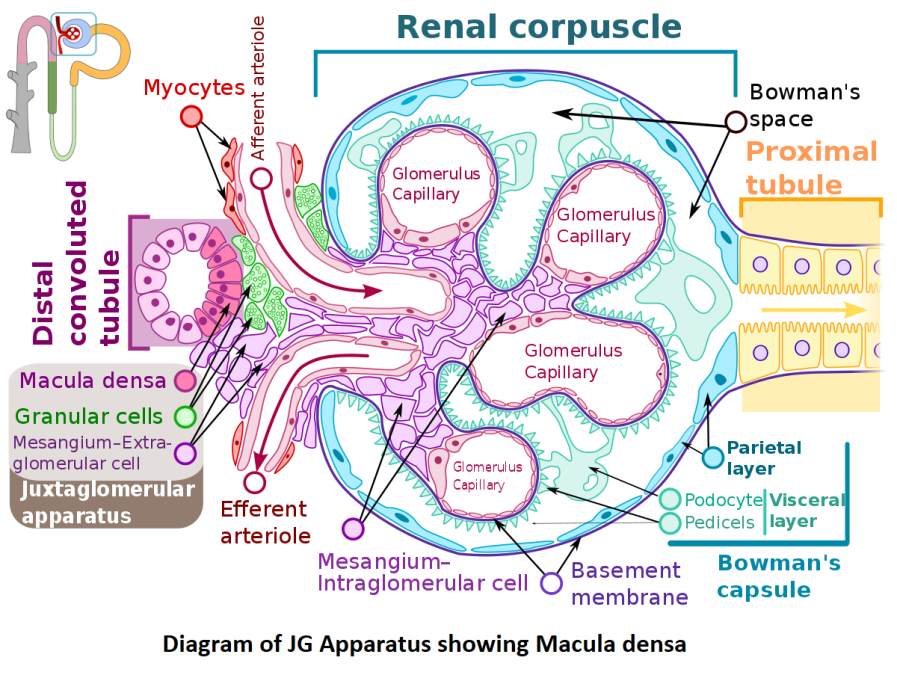
What is Macula Densa?
Answer
390.6k+ views
Hint: Juxtaglomerular apparatus is the part of the nephron and helps control the functions of the nephron. The juxtaglomerular apparatus gets its name from the fact that it is located right next to (juxta) the glomerulus. It is formed at the junction of DCT and the afferent arteriole. It controls glomerular filtration rate by controlling the renal blood flow.
Complete solution:
The macula densa is a densely packed specialized cell layer that lines the wall of the distal tubule at the place where the thick ascending limb of the Loop of Henle meets the distal convoluted tubule in the kidney.
The thickening where the distal tubule meets the glomerulus is known as the macula densa.
The concentration of sodium chloride in the distal convoluted tubule affects the cells of the macula densa. When the concentration of sodium chloride in the blood drops, the macula densa sends out a signal that has two effects:
It lowers blood pressure in the afferent arterioles, raising glomerular hydrostatic pressure and assisting in the restoration of the glomerular filtration rate (GFR) to normal.
It promotes renin release from the juxtaglomerular cells, which are the principal renin storage sites.

Note:
The macula densa cells contract the afferent arteriole in response to increased salt, lowering blood flow to the glomerulus and the glomerular filtration rate. When blood pressure in the afferent arteriole lowers, the juxtaglomerular cells of the afferent arteriole, which are derived from smooth muscle cells, emit renin. Rennin activates Rennin angiotensin aldosterone system which increases blood pressure.
Complete solution:
The macula densa is a densely packed specialized cell layer that lines the wall of the distal tubule at the place where the thick ascending limb of the Loop of Henle meets the distal convoluted tubule in the kidney.
The thickening where the distal tubule meets the glomerulus is known as the macula densa.
The concentration of sodium chloride in the distal convoluted tubule affects the cells of the macula densa. When the concentration of sodium chloride in the blood drops, the macula densa sends out a signal that has two effects:
It lowers blood pressure in the afferent arterioles, raising glomerular hydrostatic pressure and assisting in the restoration of the glomerular filtration rate (GFR) to normal.
It promotes renin release from the juxtaglomerular cells, which are the principal renin storage sites.

Note:
The macula densa cells contract the afferent arteriole in response to increased salt, lowering blood flow to the glomerulus and the glomerular filtration rate. When blood pressure in the afferent arteriole lowers, the juxtaglomerular cells of the afferent arteriole, which are derived from smooth muscle cells, emit renin. Rennin activates Rennin angiotensin aldosterone system which increases blood pressure.
Latest Vedantu courses for you
Grade 11 Science PCM | CBSE | SCHOOL | English
CBSE (2025-26)
School Full course for CBSE students
₹41,848 per year
Recently Updated Pages
Master Class 9 General Knowledge: Engaging Questions & Answers for Success

Master Class 9 English: Engaging Questions & Answers for Success

Master Class 9 Science: Engaging Questions & Answers for Success

Master Class 9 Social Science: Engaging Questions & Answers for Success

Master Class 9 Maths: Engaging Questions & Answers for Success

Class 9 Question and Answer - Your Ultimate Solutions Guide

Trending doubts
State and prove Bernoullis theorem class 11 physics CBSE

Who built the Grand Trunk Road AChandragupta Maurya class 11 social science CBSE

1 ton equals to A 100 kg B 1000 kg C 10 kg D 10000 class 11 physics CBSE

State the laws of reflection of light

One Metric ton is equal to kg A 10000 B 1000 C 100 class 11 physics CBSE

Difference Between Prokaryotic Cells and Eukaryotic Cells




